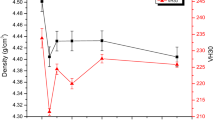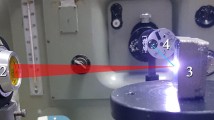Abstract
Surface hardness and microstructural properties are important parameters of plasma-facing material and play a key role in long pulse operation of fusion reactor. Nowadays, nuclear reactors are facing the problem of change in physical properties especially surface hardness due to dominant extreme conditions. Consequently, it is important to monitor these changes. Laser-induced breakdown spectroscopy (LIBS) has a potential diagnostic ability to monitor in situ surface hardness and their correlation with plasma wall interaction. In this work, the hardness of different tungsten heavy alloy grades is measured by stand-off approach using LIBS. The difference in hardness was attributed to grain size, crystal size, dislocations density and energy band gap (Eg) of materials. These microstructural and electronic structure properties have direct impact on electron temperature in laser-ablated plasma. Plasma electron temperature has been determined using Boltzmann plot method in the range from 1.76 ± 0.01 to 1.90 ± 0.02 eV, while electron density has been derived using Stark broadening spectral profile of (W-I) 429.47 nm line. The obtained direct relation between the ionic to atomic species of (WII/WI) and the material hardness are associated to increase in the value of plasma electron temperature (Te). The energy band gap of these tungsten heavy alloy targets has been observed from 3.24 to 3.59 eV as hardness increases from 314 ± 2.2 to 354 ± 1.1. The results showed that the energy band gap of these targets increases with hardness and have direct relation with plasma electron temperature. Ablation efficiency was also measured as a function of laser irradiance from crater depth analysis. The results showed that average ablation rate is decreased from soft to hard material.







Similar content being viewed by others
References
V. Philipps, Tungsten as material for plasma-facing components in fusion devices. J. Nucl. Mater. 415(1), S2–S9 (2011)
A. Loarte, B. Lipschultz, A.S. Kukushkin, G.F. Matthews, P.C. Stangeby, N. Asakura, A. Mahdavi, Power and particle control. Nucl. Fusion 47(6), S203 (2007)
J. Karhunen, A. Hakola, J. Likonen, A. Lissovski, P. Paris, M. Laan, K. Sugiyama, Development of laser-induced breakdown spectroscopy for analyzing deposited layers in ITER. Phys. Scr. 2014(T159), 014067 (2014)
J.N. Brooks, L. El-Guebaly, A. Hassanein, T. Sizyuk, Plasma-facing material alternatives to tungsten. Nucl. Fusion 55(4), 043002 (2015)
N. Farid, D. Zhao, H.Y. Oderji, H. Ding, Cracking and damage behavior of tungsten under ELM’s like energy loads using millisecond laser pulses. J. Nucl. Mater. 463, 241–245 (2015)
S.M. Aberkane, A. Bendib, K. Yahiaoui, S. Boudjemai, S. Abdelli-Messaci, T. Kerdja, M.A. Harith, Correlation between Fe–V–C alloys surface hardness and plasma temperature via LIBS technique. Appl. Surf. Sci. 301, 225–229 (2014)
R. Neu, H. Maier, M. Balden, S. Elgeti, H. Gietl, H. Greuner, I. Zammuto, Investigations on tungsten heavy alloys for use as plasma facing material. Fusion Eng. Des. 124, 450–454 (2017)
P. Lorenzo, M. Miralda, S. Iyengar, S. Melin, E. Noah, Fatigue properties and characterization of tungsten heavy alloys IT180 & D176. Int. J. Refract. Met. Hard Mater. 41, 250–258 (2013)
M. Pasalic, F. Rustempasic, S. Iyengar, S. Melin, E. Noah, Fatigue testing and microstructural characterization of tungsten heavy alloy Densimet 185. Int. J. Refract. Met. Hard Mater. 42, 163–168 (2014)
J. Habainy, S. Iyengar, Y. Lee, Y. Dai, Fatigue behavior of rolled and forged tungsten at 25, 280 and 480 C. J. Nucl. Mater. 465, 438–447 (2015)
C. Li, D. Zhao, Z. Hu, X. Wu, G.N. Luo, J. Hu, H. Ding, Characterization of deuterium retention and co-deposition of fuel with lithium on the divertor tile of EAST using laser induced breakdown spectroscopy. J. Nucl. Mater. 463, 915–918 (2015)
P. Paris, K. Piip, A. Hakola, M. Laan, M. Aints, S. Koivuranta, V. Rohde, Development of laser induced breakdown spectroscopy for studying erosion, deposition, and fuel retention in ASDEX Upgrade. Fusion Eng. Des. 98, 1349–1352 (2015)
T.O. Nagy, U. Pacher, H. Pöhl, W. Kautek, Atomic emission stratigraphy by laser-induced plasma spectroscopy: quantitative depth profiling of metal thin film systems. Appl. Surf. Sci. 302, 189–193 (2014)
R. Hai, N. Farid, D. Zhao, L. Zhang, J. Liu, H. Ding, G.N. Luo, Laser-induced breakdown spectroscopic characterization of impurity deposition on the first wall of a magnetic confined fusion device: experimental Advanced Superconducting Tokamak. Spectrochim. Acta B. 87, 147–152 (2013)
J. Karhunen, A. Hakola, J. Likonen, A. Lissovski, M. Laan, P. Paris, J.E. Contributors, Applicability of LIBS for in situ monitoring of deposition and retention on the ITER-like wall of JET-comparison to SIMS. J. Nucl. Mater. 463, 931–935 (2015)
R. Hai, X. Wu, Y. Xin, P. Liu, D. Wu, H. Ding, L. Yan, Use of dual-pulse laser-induced breakdown spectroscopy for characterization of the laser cleaning of a first mirror exposed in HL-2A. J. Nucl. Mater. 447(1–3), 9–14 (2014)
S. Wurster, N. Baluc, M. Battabyal, T. Crosby, J. Du, C. García-Rosales, R.J. Kurtz, Recent progress in R&D on tungsten alloys for divertor structural and plasma facing materials. J. Nucl. Mater. 442(1–3), S181–S189 (2013)
J.S. Cowpe, R.D. Moorehead, D. Moser, J.S. Astin, S. Karthikeyan, S.H. Kilcoyne, R.D. Pilkington, Hardness determination of bio-ceramics using laser-induced breakdown spectroscopy. Spectrochim. Acta B. 66(3–4), 290–294 (2011)
K. Tsuyuki, S. Miura, N. Idris, K.H. Kurniawan, T.J. Lie, K. Kagawa, Measurement of concrete strength using the emission intensity ratio between Ca(II) 396.8 nm and Ca(I) 422.6 nm in a Nd:YAG laser-induced plasma. Appl. Spectrosc. 60(1), 61–64 (2006)
Z.A. Abdel-Salam, A.H. Galmed, E. Tognoni, M.A. Harith, Estimation of calcified tissues hardness via calcium and magnesium ionic to atomic line intensity ratio in laser induced breakdown spectra. Spectrochim. Acta B. 62(12), 1343–1347 (2007)
Z.A. Abdel-Salam, Z. Nanjing, D. Anglos, M.A. Harith, Effect of experimental conditions on surface hardness measurements of calcified tissues via LIBS. Appl. Phys. B. 94(1), 141–147 (2009)
T.A. Labutin, A.M. Popov, V.N. Lednev, N.B. Zorov, Correlation between properties of a solid sample and laser-induced plasma parameters. Spectrochim. Acta B. 64(10), 938–949 (2009)
A.H. Galmed, C. Steenkamp, I. Ahmed, A. du Plussis, H. von Bergmann, M.A. Harith, M. Maaza, Using laser-induced breakdown spectroscopy to monitor the surface hardness of titanium samples bombarded by carbon ions. Appl. Phys. B. 124(12), 225 (2018)
S.H. Islam, X.H. Qu, F. Akhtar, P.Z. Feng, X.B. He, Microstructure and tensile properties of tungsten heavy alloys. In: Materials science forum. Trans Tech Publ. http://doi.org/10.4028/www.scientific.net/MSF.534-536.561 (2007)
H. Sattar, L. Sun, I. Muhammad, R. Hai, D. Wu, H. Ding, Effect of parameter setting and spectral normalization approach on study of matrix effect by laser induced breakdown spectroscopy of Ag-Zn binary composites. Plasma Sci. Technol. 21(3), 034019 (2019)
M. Akram, S. Bashir, M.S. Rafique, A. Hayat, K. Mahmood, A. Dawood, M.F. Bashir, Morphological and spectroscopic characterization of laser-ablated tungsten at various laser irradiances. Appl. Phys. A. 119(3), 859–870 (2015)
D. Nishijima, R.P. Doerner, Stark width measurements and Boltzmann plots of WI in nanosecond laser-induced plasmas. J. Phys. D. 48(32), 325201 (2015)
R. McWhirter, in Plasma Diagnostic Techniques, ed. by R.H. Huddlestone, S.L. Leonard (Academic Press, New York, 1965)
A.E. Morales, E.S. Mora, U. Pal, Use of diffuse reflectance spectroscopy for optical characterization of un-supported nanostructures. Rev. Mex. Fis. 53(5), 18–22 (2007)
R. López, R. Gómez, Band-gap energy estimation from diffuse reflectance measurements on sol–gel and commercial TiO2: a comparative study. J. Sol Gel. Sci. Technol. 61(1), 1–7 (2012)
G.A. Wolff, L. Toman, N.J. Field, J.C. Clark, In Halbleiter und Phosphore/Semiconductors and Phosphors/Semiconducteurs et Phosphores. Relationship of Hardness, Energy Gap and Melting Point of Diamond Type and Related Structures. (Vieweg + Teubner Verlag, Wiesbaden, 1958), pp. 463–469
A. Pawbake, R. Waykar, A. Jadhavar, R. Kulkarni, V. Waman, A. Date, S. Jadkar, Wide band gap and conducting tungsten carbide (WC) thin films prepared by hot wire chemical vapor deposition (HW-CVD) method. Mater. Lett. 183, 315–317 (2016)
L.G. Teoh, J. Shieh, W.H. Lai, I.M. Hung, M.H. Hon, Structure and optical properties of mesoporous tungsten oxide. J. Alloys. Compd. 396(1–2), 251–254 (2005)
B. Zheng, G. Jiang, W. Wang, K. Wang, X. Mei, Ablation experiment and threshold calculation of titanium alloy irradiated by ultra-fast pulse laser. AIP Adv. 4(3), 031310 (2014)
D. Bigoni, M. Milani, R. Jafer, C. Liberatore, S. Tarazi, L. Antonelli, D. Batani, Influence of mechanical and thermal material properties on laser-produced crater-morphology and their study by focused ion beam & scanning electron microscope imaging. Cal 1, M1 (2010)
Acknowledgements
This work was supported by the National Key R&D Program of China (Nos. 2017YFE0301304, 2017YFA0402501, 2017YFA0402502), the National Natural Science Foundation of China (Nos. 51837008, 11475039, 11405022, 11605023, and 11705020), China Postdoctoral Science Foundation (No. 2018M630285) and Lianoing Provincial Natural Science Foundation of China (No. 20170540153).
Author information
Authors and Affiliations
Corresponding authors
Additional information
Publisher's Note
Springer Nature remains neutral with regard to jurisdictional claims in published maps and institutional affiliations.
Rights and permissions
About this article
Cite this article
Sattar, H., Ran, H., Ding, W. et al. An approach of stand-off measuring hardness of tungsten heavy alloys using LIBS. Appl. Phys. B 126, 5 (2020). https://doi.org/10.1007/s00340-019-7355-0
Received:
Accepted:
Published:
DOI: https://doi.org/10.1007/s00340-019-7355-0




